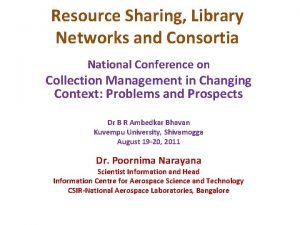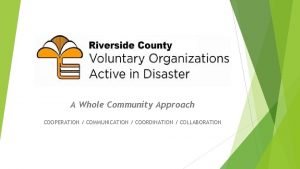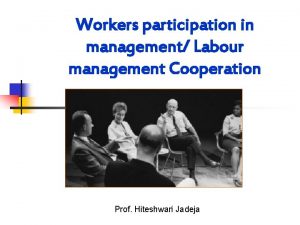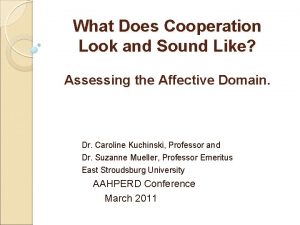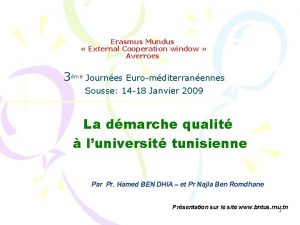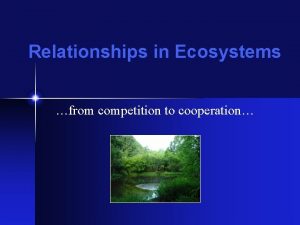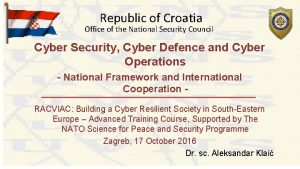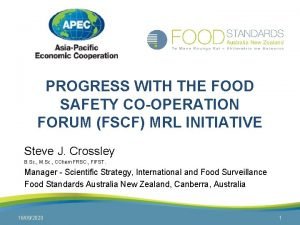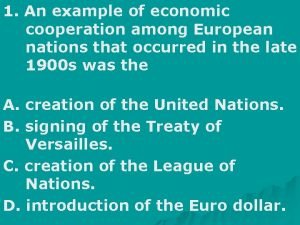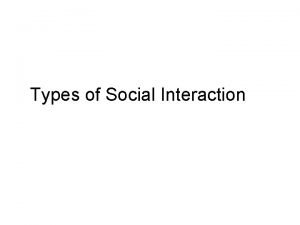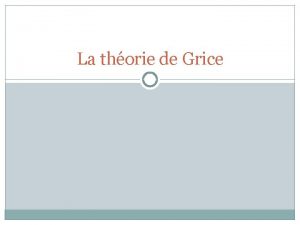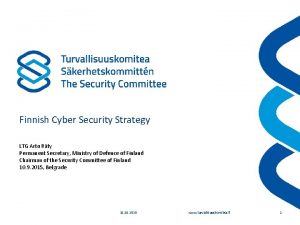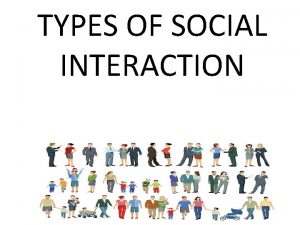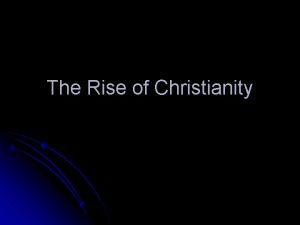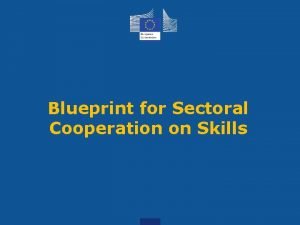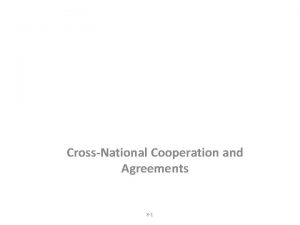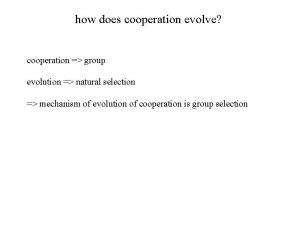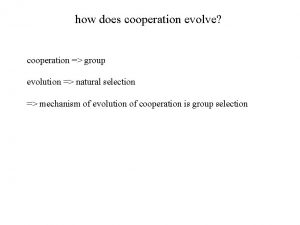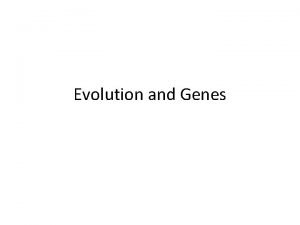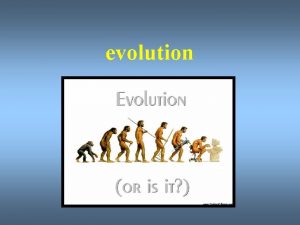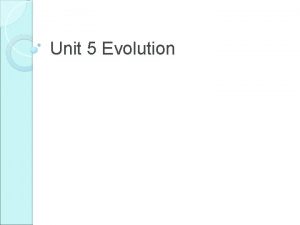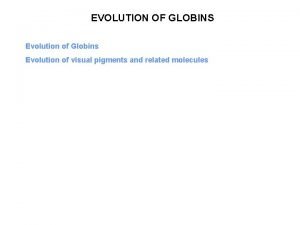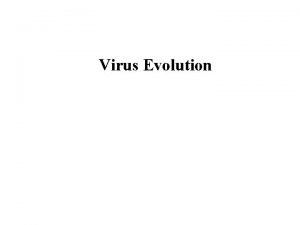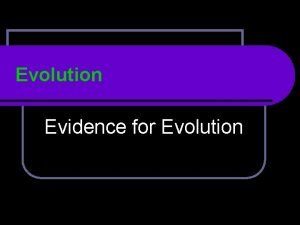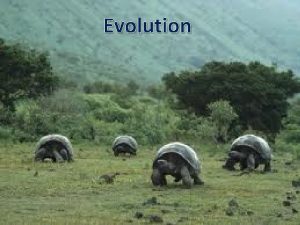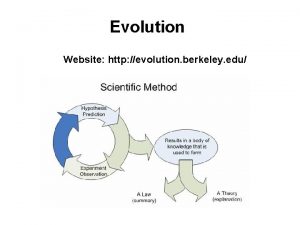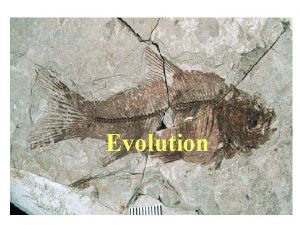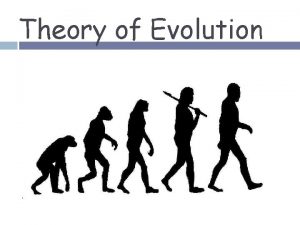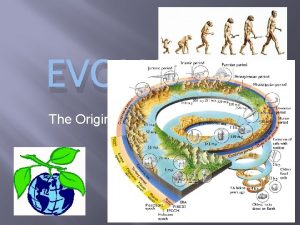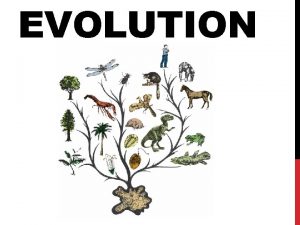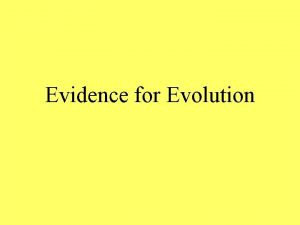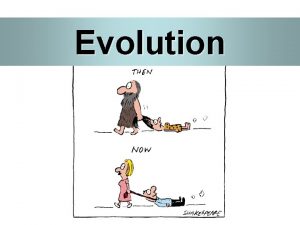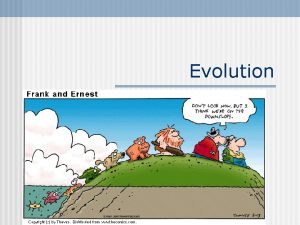The Evolution of Cooperation The Evolution of Cooperation


























































- Slides: 58

The Evolution of Cooperation

The Evolution of Cooperation I. Issue - How can cooperation evolve, especially if by cooperating, an entity reduces its own immediate fitness in sacrifice to that of another?

The Evolution of Cooperation I. Issue - How can cooperation evolve, especially if by cooperating, an entity reduces its own immediate fitness in sacrifice to that of another? - However, cooperation is OBSERVED and necessary:

The Evolution of Cooperation I. Issue - How can cooperation evolve, especially if by cooperating, an entity reduces its own immediate fitness in sacrifice to that of another? - However, cooperation is OBSERVED and necessary: among genes in a genome

The Evolution of Cooperation I. Issue - How can cooperation evolve, especially if by cooperating, an entity reduces its own immediate fitness in sacrifice to that of another? - However, cooperation is OBSERVED and necessary: among genes in a genome among organelles in a cell

The Evolution of Cooperation I. Issue - How can cooperation evolve, especially if by cooperating, an entity reduces its own immediate fitness in sacrifice to that of another? - However, cooperation is OBSERVED and necessary: among genes in a genome among organelles in a cell among cells in a multicellular organism

The Evolution of Cooperation I. Issue - How can cooperation evolve, especially if by cooperating, an entity reduces its own immediate fitness in sacrifice to that of another? - However, cooperation is OBSERVED and necessary: among genes in a genome among organelles in a cell among cells in a multicellular organism among organisms in a social group

The Evolution of Cooperation I. Issue - How can cooperation evolve, especially if by cooperating, an entity reduces its own immediate fitness in sacrifice to that of another? - However, cooperation is OBSERVED and necessary: among genes in a genome among organelles in a cell among cells in a multicellular organism among organisms in a social group between species in symbiotic relationships

The Evolution of Cooperation I. Issue II. Mechanisms (Nowak, 2006, Science). A. Kin Selection (Hamilton, 1964)

A. Kin Selection White-fronted bee-eaters r > c/b

The Evolution of Cooperation I. Issue II. Mechanisms (Nowak, 2006, Science). A. Kin Selection (W. D. Hamilton) B. Direct Reciprocity (Trivers 1971) Nowak, M. A. 2006. Five rules for the evolution of cooperation. Science 314: 1560 -1563.

The Evolution of Cooperation I. Issue II. Mechanisms (Nowak, 2006, Science). A. Kin Selection (W. D. Hamilton) B. Direct Reciprocity (Trivers 1971) - prisoners dilemma B Stays Silent B Betrays A Stays Silent both get 6 months A gets 10 years; B goes free A Betrays B gets 10 years; A goes free both get 2 years

The Evolution of Cooperation I. Issue II. Mechanisms (Nowak, 2006, Science). A. Kin Selection (W. D. Hamilton) B. Direct Reciprocity (Trivers 1971) - prisoners dilemma So, cooperation pays. . . but blind sacrifice does not! B Stays Silent B Betrays A Stays Silent both get 6 months A gets 10 years; B goes free A Betrays B gets 10 years; A goes free both get 2 years

The Evolution of Cooperation I. Issue II. Mechanisms (Nowak, 2006, Science). A. Kin Selection (W. D. Hamilton) B. Direct Reciprocity (Trivers 1971) - in the "repeated prisoner's dilemma": B Stays Silent B Betrays A Stays Silent both get 6 months A gets 10 years; B goes free A Betrays B gets 10 years; A goes free both get 2 years

The Evolution of Cooperation I. Issue II. Mechanisms (Nowak, 2006, Science). A. Kin Selection (W. D. Hamilton) B. Direct Reciprocity (Trivers 1971) - in the "repeated prisoner's dilemma": - it's adaptive to cooperate if there are repeated interactions with the same partner B Stays Silent B Betrays A Stays Silent both get 6 months A gets 10 years; B goes free A Betrays B gets 10 years; A goes free both get 2 years

The Evolution of Cooperation I. Issue II. Mechanisms (Nowak, 2006, Science). A. Kin Selection (W. D. Hamilton) B. Direct Reciprocity (Trivers 1971) - in the "repeated prisoner's dilemma": - it's adaptive to cooperate if there are repeated interactions with the same partner - it works by 'tit for tat' or 'hold if it pays' (if you start on cooperate) B Stays Silent B Betrays A Stays Silent both get 6 months A gets 10 years; B goes free A Betrays B gets 10 years; A goes free both get 2 years

The Evolution of Cooperation I. Issue II. Mechanisms (Nowak, 2006, Science). A. Kin Selection (W. D. Hamilton) B. Direct Reciprocity (Trivers 1971) - in the "repeated prisoner's dilemma": - it's adaptive to cooperate if there are repeated interactions with the same partner - it works by 'tit for tat' or 'hold if it pays' (if you start on cooperate) B Stays Silent B Betrays A Stays Silent both get 6 months A gets 10 years; B goes free A Betrays B gets 10 years; A goes free both get 2 years - cooperation can evolve only if w > c/b. . if the frequency of encounter exceeds the cost/benefit ratio of the altruistic act. If this is the case, you may profit in the future if the act is reciprocated (and if w is high, then there is good chance it will be)

The Evolution of Cooperation I. Issue II. Mechanisms (Nowak, 2006, Science). A. Kin Selection (W. D. Hamilton) B. Direct Reciprocity (Trivers 1971) - Mutualisms: both partners have increased fitness, relative to other members of their species, by interacting with another species.

The Evolution of Cooperation I. Issue II. Mechanisms (Nowak, 2006, Science). A. Kin Selection (W. D. Hamilton) B. Direct Reciprocity (Trivers 1971) - Mutualisms: both partners have increased fitness, relative to other members of their species, by interacting with another species. - Positive feedback can enhance the dependency between partners

The Evolution of Cooperation I. Issue II. Mechanisms (Nowak, 2006, Science). A. Kin Selection (W. D. Hamilton) B. Direct Reciprocity (Trivers 1971) - Mutualisms: both partners have increased fitness, relative to other members of their species, by interacting with another species. - Positive feedback can enhance the dependancy between partners Atta cephalotes, the "leaf cutter" ants, farm and eat a species of fungus that lives nowhere else now.

Acacia and Acacia ants

Corals and zooxanthellae Frugivory Aphid farming by ants Gleaners Pollination Protozoans in Termites

II. Mechanisms (Nowak, 2006, Science). A. Kin Selection (W. D. Hamilton) B. Direct Reciprocity (Trivers 1971) C. Indirect Reciprocity – “reputation” “watcher” Nowak, M. A. 2006. Five rules for the evolution of cooperation. Science 314: 1560 -1563.

The Evolution of Cooperation I. Issue II. Mechanisms (Nowak, 2006, Science). A. Kin Selection (W. D. Hamilton) B. Direct Reciprocity (Trivers 1971) C. Indirect Reciprocity (Nowak 1998) - In large populations (humans), the frequency of encounter may be low, and the relationship is asymmetric (one person CAN help, the other may never be able to).

The Evolution of Cooperation I. Issue II. Mechanisms (Nowak, 2006, Science). A. Kin Selection (W. D. Hamilton) B. Direct Reciprocity (Trivers 1971) C. Indirect Reciprocity (Nowak 1998) - In large populations (humans), the frequency of encounter may be low, and the relationship is asymmetric (one person CAN help, the other may never be able to). - Helping establishes a good reputation; and increases the chance that others (not the direct beneficiaries) will help us if we need it.

The Evolution of Cooperation I. Issue II. Mechanisms (Nowak, 2006, Science). A. Kin Selection (W. D. Hamilton) B. Direct Reciprocity (Trivers 1971) C. Indirect Reciprocity (Nowak 1998) - In large populations (humans), the frequency of encounter may be low, and the relationship is asymmetric (one person CAN help, the other may never be able to). - Helping establishes a good reputation; and increases the chance that others (not the direct beneficiaries) will help us if we need it. - People who are observed to be more helpful are more likely to be helped.

- Even in other species. . . Bshry 2006 - Cleaner Wrasse - wrasse eat parasites off "client" fish. . . but they can cheat and eat mucous, which is bad for the client fish.

- Even in other species. . . Bshry 2006 - Cleaner Wrasse - wrasse eat parasites off "client" fish. . . but they can cheat and eat mucous, which is bad for the client fish. - Client fish observe wrasses, and prefer the wrasses that don't cheat

- Even in other species. . . Bshry 2006 - Cleaner Wrasse - wrasse eat parasites off "client" fish. . . but they can cheat and eat mucous, which is bad for the client fish. - Client fish observe wrasses, and prefer the wrasses that don't cheat - AND, when WATCHED, wrasses cheat less and cooperate more. . .

- Even in other species. . . Bshry 2006 - Cleaner Wrasse - wrasse eat parasites off "client" fish. . . but they can cheat and eat mucous, which is bad for the client fish. - Client fish observe wrasses, and prefer the wrasses that don't cheat - AND, when WATCHED, wrasses cheat less and cooperate more. . . - so wrasses cooperate with current clients to gain favor (reputation) with others that are observing. - cooperation can only evolve IF q > c/b, where: q = prob. of knowing someone's reputation

C. Indirect Reciprocity – “reputation” D. Network Reciprocity http: //www. youtube. com/watch? v=frpp 6 Dj. Ca. JU Nowak, M. A. 2006. Five rules for the evolution of cooperation. Science 314: 1560 -1563.

C. Indirect Reciprocity – “reputation” D. Network Reciprocity E. Group Selection Nowak, M. A. 2006. Five rules for the evolution of cooperation. Science 314: 1560 -1563.

E. Group Selection Pseudomonas flourescens Colonies with high concentration of mat-builders (expensive proteins) float; if cheaters increase in number, colony sinks and dies. Nowak, M. A. 2006. Five rules for the evolution of cooperation. Science 314: 1560 -1563.

E. Group Selection “givers and takers” and Evolutionarily Stable Strategies Scenario 1: Payoff to hawks is always greater than payoff to doves, regardless of density. Even though all doves is better for the group, it is not an ESS… it can be ‘invaded’ by hawks. All hawks IS an ESS, though, because doves always at disadvantage and can’t increase in population.

E. Group Selection “givers and takers” and Evolutionarily Stable Strategies Scenario 2: Here, the cost of competition among hawks is high, so as hawk density increases, payoff to hawks decline rapidly. A population of all hawks is not an ESS now – it can be invade by doves. There is a stable equilibrium in which hawks and doves are maintained in the population. c

The Evolution of Cooperation I. Issue II. Mechanisms (Nowak, 2006, Science). Conclusions - cooperation can evolve as a result of selection; even among unrelated entities (symbioses) - when cooperation occurs at one level, it creates a new level of organization. . . cells cooperate and ORGANISMS are produced. . . organisms cooperate and SOCIAL UNITS are produced. - Cooperation allows specialization, and creates diversity at several levels

Vogel, G. 2004. Evolution of the golden rule. Science 303: 1128 -1131. Game: Give one monkey a pebble. If it gives it back (cooperation), it gets a cucumber slice.

Vogel, G. 2004. Evolution of the golden rule. Science 303: 1128 -1131. GRAPE? … what the $%#@@!! Game: Give one monkey a pebble. If it gives it back (cooperation), it gets a cucumber slice. Repeat with a second monkey, in view of the first, but give the second monkey a grape (better reward).

Vogel, G. 2004. Evolution of the golden rule. Science 303: 1128 -1131. Game: KEEP your #$#@ CUCUMBER!! Give one monkey a pebble. If it gives it back (cooperation), it gets a cucumber. Repeat with a second monkey, in view of the first, but give the second monkey a grape (better reward). First monkey will no longer return the pebble for a cucumber. Fair trade. Capuchin monkeys refuse to cooperate when they see a comrade receive a better reward for the same task.

Chimps helping strangers http: //www. plosbiology. org/article/info: doi/10. 1371/journal. pbio. 005018 4 • 36 wild-born chimps (orphaned) – Uganda • Two novel experimenters struggle over stick, thrown in cage • Experimenter reaches for stick • Does chimp help and get the stick in 60 sec? How about a child? Chimp Child

Chimps helping strangers http: //www. livescience. com/animals/070625_chimp_altruism. html yes, as often as 18 month old children if the experimenter reaches for it.

Chimps helping strangers http: //www. livescience. com/animals/070625_chimp_altruism. html Still, humans at the sanctuary provide the chimpanzees food and shelter, so helping people out could simply be in their best interests.

Chimps helping strangers http: //www. livescience. com/animals/070625_chimp_altruism. html 9 unrelated chimps ‘trained’ to use a mechanism in a pre-test. They remove the peg, and then can walk around the corner, through the newly opened port, and get the food.

Chimp helping chimp • Both the target and the distracter door were held shut by chains. • subject (S) could release the chain of the target door. • In the experimental condition, food was placed in the target room (subject could help) by releasing the target chain. In the control condition, food was placed in the distracter room, so that the recipient would try to open the distracter door. In this situation, it was irrelevant (with respect to the recipient's attempt to open the distracter door) whether the subject released the target chain. The target measure in both conditions was whether the subject released the target chain. (from Warneken, PLOS 2007). • 3 acted as recipients and 6 as subjects – 10 trials for each pairing; 5 experimental and 5 controls (banana in ‘distractor’ room).

Mean percentage of trials with target behavior (releasing the target chain) by condition. Error bars represent SEM. Each subject was tested in both conditions in a within-subject comparison. (Warneken, PLOS 2007). Subjects pull bar for recipient to access food significantly more often than the control (p < 0. 025). Difference increased over trials.

The Evolution of Cooperation Conflicts within Families

The Evolution of Cooperation I. Issue II. Mechanisms (Nowak, 2006, Science). III. Conflicts A. Parent vs. Offspring Parent’s potential for future reproduction may favor them investing in survival rather than parental care.

The Evolution of Cooperation I. Issue II. Mechanisms (Nowak, 2006, Science). III. Conflicts A. Parent vs. Offspring D. Conflicts within Families 2. Parent - offspring Selection can favor parents that abort care of current offspring to improve survival and future reproductive success…

B. Parent-Parent IGFII gene – stimulates growth On in males, stimulating the growth of their own offspring; off in females, as she bears the cost of growing embryos and all are hers.

B. Parent-Parent IGFII inhibitor gene – slows growth Off in males, stimulating the growth of their own offspring; on in females, as she bears the cost of growing embryos and all are hers.

C. Sibling - sibling

B. Sibling - sibling

Conflicts. . I. Among Relatives II. Among Non-Relatives A. Interspecific Competition

Conflicts. . I. Among Relatives II. Among Non-Relatives A. Interspecific Competition - within both populations, those that are competing within AND between species are at an energetic and reproductive disadvantage.

Conflicts. . I. Among Relatives II. Among Non-Relatives A. Interspecific Competition - within both populations, those that are competing within AND between species are at an energetic and reproductive disadvantage. - competititive exclusion

Conflicts. . I. Among Relatives II. Among Non-Relatives A. Interspecific Competition - within both populations, those that are competing within AND between species are at an energetic and reproductive disadvantage. - competititive exclusion - niche partitioning

Conflicts. . I. Among Relatives II. Among Non-Relatives A. Interspecific Competition - within both populations, those that are competing within AND between species are at an energetic and reproductive disadvantage. - competititive exclusion - niche partitioning

Conflicts. . I. Among Relatives II. Among Non-Relatives A. Interspecific Competition - within both populations, those that are competing within AND between species are at an energetic and reproductive disadvantage. - competititive exclusion - niche partitioning; character displacement Both species benefit by reducing the interaction; once it is reduced, there is no benefit to reestablish the interaction.
 Pic pharmaceutical inspection convention
Pic pharmaceutical inspection convention Erasmus mundus external cooperation window
Erasmus mundus external cooperation window International civil aviation organization jobs
International civil aviation organization jobs European cooperation for accreditation
European cooperation for accreditation Library cooperation
Library cooperation Agriculture cooperation and farmers welfare
Agriculture cooperation and farmers welfare Communication cooperation coordination collaboration
Communication cooperation coordination collaboration Joint management council
Joint management council Asia-pacific economic cooperation forum
Asia-pacific economic cooperation forum Collaboration or cooperation
Collaboration or cooperation What does cooperation sound like
What does cooperation sound like Business process cooperation viewpoint
Business process cooperation viewpoint Erasmus mundus external cooperation window
Erasmus mundus external cooperation window Cooperation relationship ecosystem
Cooperation relationship ecosystem Nis cooperation group
Nis cooperation group Apec food safety cooperation forum
Apec food safety cooperation forum Working group on international cooperation
Working group on international cooperation Contractual brief example
Contractual brief example What is one way that cooperation helps lions to survive
What is one way that cooperation helps lions to survive Economic cooperation examples
Economic cooperation examples Cooperation interaction examples
Cooperation interaction examples Communication coordination cooperation during the emergency
Communication coordination cooperation during the emergency Cyber cooperation
Cyber cooperation Implicature conventionnelle
Implicature conventionnelle Offer for cooperation
Offer for cooperation Mutual cooperation agreement template
Mutual cooperation agreement template Arto räty
Arto räty International laboratory accreditation cooperation
International laboratory accreditation cooperation Cooperation social interaction
Cooperation social interaction International laboratory accreditation cooperation (ilac)
International laboratory accreditation cooperation (ilac) Christianity
Christianity Blueprint for sectoral cooperation on skills
Blueprint for sectoral cooperation on skills Oecd gps
Oecd gps Interamerican accreditation cooperation
Interamerican accreditation cooperation Cross national cooperation
Cross national cooperation Thiếu nhi thế giới liên hoan
Thiếu nhi thế giới liên hoan điện thế nghỉ
điện thế nghỉ Một số thể thơ truyền thống
Một số thể thơ truyền thống Trời xanh đây là của chúng ta thể thơ
Trời xanh đây là của chúng ta thể thơ Thế nào là hệ số cao nhất
Thế nào là hệ số cao nhất Sơ đồ cơ thể người
Sơ đồ cơ thể người So nguyen to
So nguyen to Tia chieu sa te
Tia chieu sa te đặc điểm cơ thể của người tối cổ
đặc điểm cơ thể của người tối cổ Các châu lục và đại dương trên thế giới
Các châu lục và đại dương trên thế giới Chụp tư thế worms-breton
Chụp tư thế worms-breton ưu thế lai là gì
ưu thế lai là gì Tư thế ngồi viết
Tư thế ngồi viết Bàn tay mà dây bẩn
Bàn tay mà dây bẩn Mật thư anh em như thể tay chân
Mật thư anh em như thể tay chân Các châu lục và đại dương trên thế giới
Các châu lục và đại dương trên thế giới Bổ thể
Bổ thể Tư thế ngồi viết
Tư thế ngồi viết Thẻ vin
Thẻ vin Ví dụ về giọng cùng tên
Ví dụ về giọng cùng tên Thơ thất ngôn tứ tuyệt đường luật
Thơ thất ngôn tứ tuyệt đường luật Chúa yêu trần thế alleluia
Chúa yêu trần thế alleluia Từ ngữ thể hiện lòng nhân hậu
Từ ngữ thể hiện lòng nhân hậu




